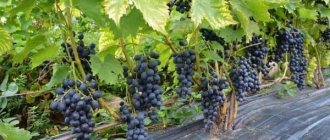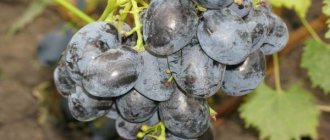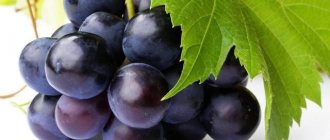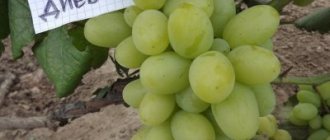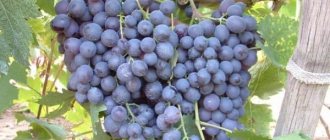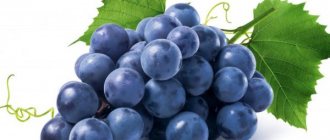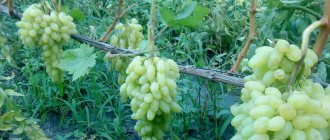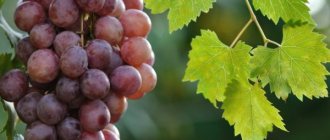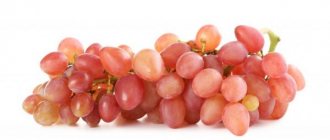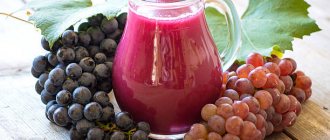- Characteristics of Muscat Rose
- Localities
- Growing and care
- Productivity of the variety
- Possible diseases
- Winemaking
Among technical grapes, pink varieties are in best demand among winemakers. In Italy, professional winegrowers say that pink grapes are first tasted with the eyes, and then their taste properties are assessed. The rose muscat variety is of particular value to winemakers.
Early grape variety Muscat Pink
Characteristics of Muscat Rose
Since Muscat Pink belongs to an early variety, its bushes grow at a moderate pace, their leaves are dense. Young shoots are slightly drooping and when ripe their color becomes light brown, but the nodes of the vine are darker. The second-order pagons are not fully formed. The growing shoot has a pink crown with a noticeable red tint. The leaves of Muscat Rose are similar to the leaves of Muscat White.
According to the description, their characteristic features are as follows:
- large or medium shape;
- rounded;
- color - green;
- slightly downward slope;
- small cuts are noticeable;
- the edge of the leaf is slightly directed upward;
- five-lobed;
- small sharp teeth along the edges;
- to the touch, the top of the leaf is smooth, sparse bristles are felt below;
- their upper cuts are open or closed with an average depth;
- the lower sections are only closed.
The size of the inflorescences is average. It is important that the flowers are bisexual and self-pollinating. The berries are larger in size than the White Muscat berries: length - from 110 to 180 mm, width - from 100 to 170 mm. Their color is dark red, a thick wax-like layer is felt. Their shape is round with thick skin. The description of the berries of this variety notes a pronounced nutmeg aroma. Fully ripened fruits acquire a dark, almost black color. The presence of seeds in them is from 2 to 4 pieces. Fruits are sugary: about 35 g/100 ml.
Muscat Pink grape - round with thick skin
The size of the Muscat Pink bunch is average, cylindrical-conical in shape with a powerful stalk. The weight of one bunch is approximately 200 grams.
Description
Its clusters and berries are medium in size, yellow with a golden tan on the sunny side. The pulp is very juicy, tender and fragrant. Connoisseurs detect notes of floral scents, tea rose, citron, and honey in the aroma. The ripening period is early-medium (140 days), while technical ripeness occurs later, with some wilting of the berries and, as a consequence, maximum accumulation of sugars. High sugar content is combined with sufficient acidity. The yield is average; to increase it, additional pollination is carried out.
The bushes are medium-sized, the ripening of shoots is good. They are grown on trellises, fan molding is used, and pruning is done to 6-8 eyes. Harvests are best achieved in poor soils with average moisture.
a brief description of
| Color | yellow |
| Form | rounded |
| 3-4 g / 0.3 kg | |
| 4,3 / 5 |
| Term | early-middle |
| average | |
| -21°С | |
| weak |
White Muscat loves potassium supplements. A feature of the culture is the early beginning and end of the growing season, while the higher the vineyard above sea level, the shorter the growing season - buds bloom later, and leaf fall occurs earlier. Resistance is low - it is affected by oidium, mildew and gray mold, and among the pests, spider mites and leaf rollers often settle on the leaves. Frost resistance is low.
Localities
The Early Pink Muscat variety is grown not only in home gardens, but also in large areas for industrial plants. Wines from it are made of the highest quality, delicious desserts are made, and they are also used fresh. Pink early nutmeg is one of the varieties of white nutmeg. It happened several centuries ago in the southern part of Europe. The species belongs to early maturation. Many countries grow it, not excluding Russia. The Crimean lands are the best in terms of fertility for such grapes. It is popular in Italy, Portugal, France, Armenia, Kazakhstan, Uzbekistan and other countries.
Muscat extra early red
And one more table variety belonging to the noble family of Muscats is the super-early red (form No. XVII-10-26), which was also bred by Moldavian breeders.
Its “zest” is its exceptionally early fruiting (ripening period 95-100 days). The harvest begins in the second half of July, however, according to reviews from winegrowers, after that it can easily hang on the bush for another couple of months. Externally, the shape is very similar to the famous Cardinal variety. The mass of the bunches is 0.3-0.6 kg, the berries are 4-5g, they are red-violet in color. Red nutmeg is famous for its harmonious taste, and its flesh has a pleasant crunch. Sugar content 15-18%, acidity 5-7 g/l. Transportability is high.
Depending on the level of agrotechnical background, bushes can develop medium or high growth vigor. Pruning - by 6-8 buds, leaving about 40 eyes per plant.
a brief description of
| Color | red |
| Form | rounded |
| 4-5 g / 0.3 kg | |
| 4,5 / 5 |
| Term | early |
| average | |
| -23°С | |
| average |
Resistance is average to both oidium and mildew. The form can withstand temperatures down to -23°C in winter, and like all nutmegs, it needs shelter for the winter. A feature of the form is the so-called “accumulation of old wood” - when the size of the berries and bunches increases with the age of the plants.
Growing and care
Before planting the early Muscat Rose bush, you must:
- choose the optimal location for a given variety;
- dig a planting hole;
- fill the hole with fertile soil mixed with minerals and manure;
- make a small mound in the middle of the hole and insert a grape cutting into it;
- fill the hole with soil until the growth begins;
- cover the seedling with a cut plastic bottle;
- Water the seedling well.
Spring planting is carried out from mid-April to the end of May. In autumn, this variety is planted in September-October.
From one hectare you can collect 60 - 80 centners of crop
In the first years of grape growth, the soil near the bush periodically needs to be loosened and weeded. In early spring, thin roots are cut off, as they inhibit the development of the root system. Pink nutmeg is watered four times a year . Mineral and organic fertilizers are periodically applied. By adhering to these rules, you can grow a decent harvest and quality fruits.
Features of Muscat grape varieties
In any Muscat variety or hybrid form of grapes, the brightest tones of Muscat appear exclusively at the stage of physiological maturity of the fruit, which is due to the presence of thornoid compounds contained in the skin of the berry, as well as the pulp under the skin.
The high quality and taste characteristics of the berries are of great importance. Many people like the nutmeg taste, and the berries are quite sweet and have pronounced phytoncidal properties, which improve the microflora of the gastrointestinal tract.
The Muscat grape is a very old variety, native to Central Asia. “Muscat” has become widespread throughout the world, and on its basis it has been possible to obtain many new, very interesting, high-quality varieties.
Advantages and disadvantages
Early ripening bunches
of Muscat grape varieties have the following advantages:
- Fast ripening of berries;
- excellent taste, aroma;
- good preservation of the crop;
- excellent transportability;
- ease of care.
The disadvantages of these varieties include the following qualities:
- Probability of freezing in spring;
- some varieties have peas;
- poor resistance to diseases and pests.
Description of varieties, characteristics with photos
In order to figure out which type of Muscat is better, you need to study their description and characteristics in detail.
White extra early
A bunch of white Muscat Muscat
White extra early is one of the old, widely known, technical, high-yielding varieties. The homeland of the variety is Syria and Egypt. The grapes are grown in the south of Russia, Italy, Romania and the USA.
The bush is medium-sized. Young shoots grow straight, slightly bending at the edges. The vine ripens at 80-90% of the length of the shoots. The shoots bear fruit by 40%. The leaves are large. The shape is solid or consists of 3-5 blades. The tips of the leaves have sharp-angled serrations, the edges have a light border. The lower part of the leaf is covered with greenish veins. In autumn the leaves turn yellow.
The flowers of the plant are bisexual. The bunch is cylindrical, with or without a wing. Weight 110-400 grams. The clusters are removed 140-145 days after the start of flowering (early October). From 1 hectare the variety produces 60-100 centners of grapes. To increase productivity, it is recommended to carry out additional pollination of flowers.
Bunch of ripe Muscat
The berries are round, often deformed, medium in size, weighing 3-4 grams. Each berry contains 2-3 seeds. The skin is yellow-golden, dense, covered with a waxy coating. The aroma is bright, nutmeg, with light pink notes. The flesh is tender. The taste is rich, with a slight citrus aftertaste.
Sugar content is 20-30%. The berries are well stored and can easily be transported over long distances. These grapes are very tasty fresh and are also ideal for making raisins, juice, and wines.
This variety requires care. White Muscat has weak immunity to oidium, bitter and gray rot, powdery mildew and mildew. Without preventive spraying, a plant is often affected by spider mites and phylloxera. The grapes have poor cold resistance. It can withstand temperatures down to -16 degrees below zero. In severe frosts, it needs to be covered for the winter. The plant suffers during spring frosts.
Pink
Bunches of pink grapes
Muscat Pink is a variety of White Muscat, known since ancient times. This mid-season variety is grown in Russia, Kazakhstan, Uzbekistan, southern France, Italy, Portugal, and Ukraine.
The ripening of berries extends from early August to mid-September. The growing season is 138-140 days. Up to 80 centners of grapes are harvested per hectare.
The bush is medium, very dense. The shape is round. The shoots are directed downwards. The development of stepchildren is slow. During the season they reach an average length, or do not have time to form. The stems turn yellowish-brown when ripe. The shoots bear fruit by 75-90%.
The leaves are large and round in shape. The edge rugosity is insignificant. The upper part of the leaf is smooth, the lower part is covered with bristles. The leaf consists of 5 blades. The leaves are inclined downwards. The upper part is slightly upturned.
Bunch of pink grapes
The inflorescences are loose, of medium size, the flowers are self-pollinating. The clusters are medium, conical. The legs become woody when ripe. Weight reaches 200 grams.
The berries are round and medium. The skin turns dark red when fully ripe. The width of the berries is 7-10 millimeters. Length – 11-18 millimeters. The skin is dense and thin. The pulp is juicy, soft, covered with a waxy coating. The taste and aroma are pronounced, harmonious, with nutmeg notes. The sugar content of grapes reaches 24%. Acidity up to 9.1 g/l.
The berries are consumed fresh and used to make desserts, juices, salads, and wines. Early Pink Muscat is sensitive to cold and drought. During spring frosts, there is a possibility of shoots freezing. The plant is prone to mildew, gray mold, oidium, phylloxera, and cluster budworm.
Novoshakhtinsky
Harvest of the Novoshakhtinsky variety
Novoshakhtinsky Muscat is an early ripening, high-yielding variety. The ripening period for this table variety begins at 100-115 days. Full ripening of the grapes occurs by the beginning of August. The vines ripen to their full length. The flowers are self-pollinating. The clusters are large. Weight reaches 600 grams.
The berries are reddish-purple, large, reaching 10 grams. Each berry contains 2-3 seeds. The skin is thin, barely noticeable, dense, and does not crack. The pulp is juicy and crispy. The aroma is characteristic of the variety, nutmeg-caramel. Sugar content - 30%.
When ripe, the berries are stored on the vine for a long time and do not lose their appearance and taste. It belongs to the technical variety of this crop and is used fresh and for making juices and wines. The grapes tolerate transportation and storage well. The variety is resistant to frost. It tolerates cold temperatures down to -24 degrees. Disease resistance is average.
Hamburg
Clusters of ripe Hamburg variety
Muscat Hamburg is a table, mid-late variety. The growing season is 148 days. The berries ripen in mid-September. Productivity is high, but unstable. Fruiting of shoots is 67%. The variety is grown in Russia, Hungary, Romania, Argentina, Tunisia, Greece, France, and the USA.
Medium sized bushes. In rich soils, plant growth increases. The shoots are densely leafy. The annual shoot is brown, the nodes are reddish in color. The leaves are large and of medium length. The shape is heart-shaped, deeply and moderately dissected, consists of 5 wavy lobes. The edges are corrugated.
The leaves are pubescent. Green color with bronze flecks. The cloves are wine-red. In autumn the leaves turn yellow.
The clusters are large or medium, conical, branched, loose, large. The leg is medium, grassy green. The weight of the bunch is 170-260 grams. The length reaches 20 centimeters. Width – 12-17 centimeters.
Flowers are bisexual.
The berries are oval or round, large, and often burst when the flowers freeze. Their length is 1.3-2.6 centimeters, diameter - 1.2-1.7 centimeters. The skin is violet-blue, dense, covered with a waxy coating. The pulp is fleshy and juicy. The taste is harmonious and pleasant. The aroma is nutmeg, subtle. 1 berry contains 2-3 large seeds.
- Tasting rating on a ten-point scale: 9.1 points.
- Sugar content is 22 milliliters. Acidity 8 g/l.
- The grapes are transportable and can be stored for 2.5-3 months.
Grapes make delicious juices, marinades, compotes and jams. Disease resistance is low. The variety is heat-loving, demanding on humidity and soil.
- The variety has poor resistance to gray rot, oidium, bacterial canker, mildew, and phylloxera.
- Resistance to damage by bunch budworm is average.
- Frost resistance is weak. The bush can withstand frosts down to -19 degrees. After a cold spring, peas appear.
Due to low frost resistance, grapes need to be shaped like a double-armed Guyot. The cutting length is 4-6 eyes. The bush's load should be 18-20 shoots (of which 12 are fruitful).
In warm regions, you can use a high-standard, double-shouldered cordon formation. The height of the trunk is 1.2 meters. Pruning of shoots is shortened and depends on the integrity of the eyes after winter.
Noble
Clusters of Noble Muscat
Noble Muscat is a hybrid form of very early grape. The berries ripen in 105-115 days. Productivity is high.
The bush is tall. The vines ripen almost the entire length of the shoots. Flowers are bisexual. The clusters are conical, large, medium dense and loose. Average weight 600 grams.
The berries weigh 13-16 grams, measure 40 by 30 millimeters, and are ovoid in shape. The skin is dense, thin, almost imperceptible, greenish-yellow or white, yellow and translucent on the sun side.
The pulp is juicy and fleshy. The taste is nutmeg.
- Frost resistance at 15-23 degrees.
- Disease resistance at level 3.
- Commodity quality and transportability are high.
- Wasps do not damage the berries.
Moscow
Ripe Moscow grape
Muscat Moscow is an early table grape variety. One bush produces about 4.7 kilograms of grapes. The shape of the bush when pruned is fan-shaped, multi-armed, and without a standard. The cutting length is short or medium. The bush is tall. The leaves are large. Pubescence is completely absent.
The clusters are medium, large, weighing 480 grams. The shape is cylindrical-conical. The berries are oval, light green, medium. Each berry contains 2-3 seeds. The taste is harmonious, with a hint of nutmeg.
Sugar content of berries is 17.5%. Acidity is 6 g/l.
Tasting rating on a ten-point scale: 8.2 points.
The plant needs crop rationing. Susceptibility to diseases without preventive spraying is 60%, spider mites up to 60%.
Frost resistance of the bush is up to -25 degrees.
